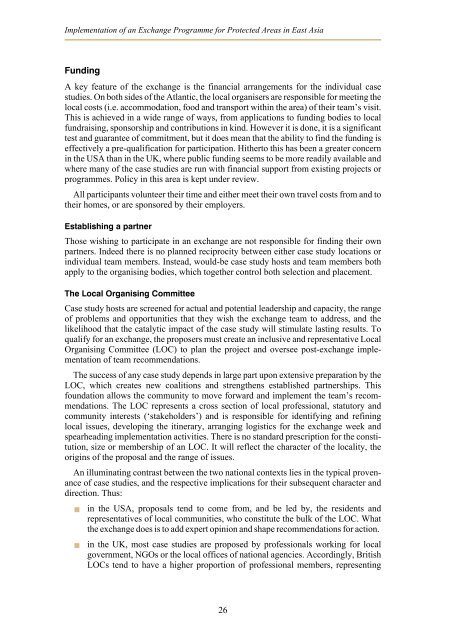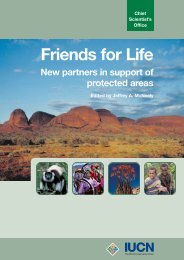Exchange programmes - IUCN
Exchange programmes - IUCN
Exchange programmes - IUCN
Create successful ePaper yourself
Turn your PDF publications into a flip-book with our unique Google optimized e-Paper software.
Implementation of an <strong>Exchange</strong> Programme for Protected Areas in East Asia<br />
Funding<br />
A key feature of the exchange is the financial arrangements for the individual case<br />
studies. On both sides of the Atlantic, the local organisers are responsible for meeting the<br />
local costs (i.e. accommodation, food and transport within the area) of their team’s visit.<br />
This is achieved in a wide range of ways, from applications to funding bodies to local<br />
fundraising, sponsorship and contributions in kind. However it is done, it is a significant<br />
test and guarantee of commitment, but it does mean that the ability to find the funding is<br />
effectively a pre-qualification for participation. Hitherto this has been a greater concern<br />
in the USA than in the UK, where public fundingseems to be more readily available and<br />
where many of the case studies are run with financial support from existingprojects or<br />
<strong>programmes</strong>. Policy in this area is kept under review.<br />
All participants volunteer their time and either meet their own travel costs from and to<br />
their homes, or are sponsored by their employers.<br />
Establishing a partner<br />
Those wishingto participate in an exchange are not responsible for findingtheir own<br />
partners. Indeed there is no planned reciprocity between either case study locations or<br />
individual team members. Instead, would-be case study hosts and team members both<br />
apply to the organising bodies, which together control both selection and placement.<br />
The Local Organising Committee<br />
Case study hosts are screened for actual and potential leadership and capacity, the range<br />
of problems and opportunities that they wish the exchange team to address, and the<br />
likelihood that the catalytic impact of the case study will stimulate lastingresults. To<br />
qualify for an exchange, the proposers must create an inclusive and representative Local<br />
Organising Committee (LOC) to plan the project and oversee post-exchange implementation<br />
of team recommendations.<br />
The success of any case study depends in large part upon extensive preparation by the<br />
LOC, which creates new coalitions and strengthens established partnerships. This<br />
foundation allows the community to move forward and implement the team’s recommendations.<br />
The LOC represents a cross section of local professional, statutory and<br />
community interests (‘stakeholders’) and is responsible for identifyingand refining<br />
local issues, developing the itinerary, arranging logistics for the exchange week and<br />
spearheadingimplementation activities. There is no standard prescription for the constitution,<br />
size or membership of an LOC. It will reflect the character of the locality, the<br />
origins of the proposal and the range of issues.<br />
An illuminatingcontrast between the two national contexts lies in the typical provenance<br />
of case studies, and the respective implications for their subsequent character and<br />
direction. Thus:<br />
� in the USA, proposals tend to come from, and be led by, the residents and<br />
representatives of local communities, who constitute the bulk of the LOC. What<br />
the exchange does is to add expert opinion and shape recommendations for action.<br />
� in the UK, most case studies are proposed by professionals workingfor local<br />
government, NGOs or the local offices of national agencies. Accordingly, British<br />
LOCs tend to have a higher proportion of professional members, representing<br />
26






